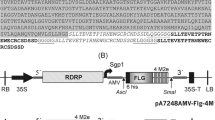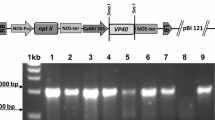Abstract
Objective
Hepatitis E virus (HEV) infection is a major cause of acute hepatitis worldwide. The aim of the study is the development of plant expression system for the production of virus-like particles formed by HEV capsid and the characterization of their immunogenicity.
Results
Open reading frame (ORF) 2 encodes the viral capsid protein and possesses candidate for vaccine production. In this study, we used truncated genotype 3 HEV ORF 2 consisting of aa residues 110 to 610. The recombinant protein was expressed in Nicotiana benthamiana plants using the self-replicating potato virus X-based vector pEff up to 10% of the soluble protein fraction. The yield of HEV 110-610 after purification was 150–200 µg per 1 g of green leaf biomass. The recombinant protein formed nanosized virus-like particles. The immunization of mice with plant-produced HEV 110-610 protein induced high levels of HEV-specific serum antibodies.
Conclusions
HEV ORF 2 (110-610 aa) can be used as candidate for the development of a plant-produced vaccine against Hepatitis E.





Similar content being viewed by others
Abbreviations
- HEV:
-
Hepatitis E virus
- ORF:
-
Open reading frame
- PVX:
-
Potato virus X
References
Bradley D, Andjaparidze A, Cook EH, McCaustland K, Balayan M, Stetler H, Velazquez O, Robertson B, Humphrey C, Kane M (1988) Aetiological agent of enterically transmitted non-A, non-B hepatitis. J Gen Virol 69:731–738
Cao YF, Tao H, Hu YM, Shi CB, Wu X, Liang Q, Chi CP, Li L, Liang ZL, Meng JH, Zhu FC, Liu ZH, Wang XP (2017) A phase 1 randomized open-label clinical study to evaluate the safety and tolerability of a novel recombinant Hepatitis E vaccine. Vaccine 35:5073–5080
Cao Y, Bing Z, Guan S, Zhang Z, Wang X (2018) Development of new Hepatitis E vaccines. Hum Vaccin Immunother 14:2254–2262
Debing Y, Moradpour D, Neyts J, Gouttenoire J (2016) Update on Hepatitis E virology: implications for clinical practice. J Hepatol 65(1):200–212
Emerson SU, Clemente-Casares P, Moiduddin N, Arankalle VA, Torian U, Purcell RH (2006) Putative neutralization epitopes and broad cross-genotype neutralization of Hepatitis E virus confirmed by a quantitative cell-culture assay. J Gen Virol 87:697–704
Goel A, Aggarwal R (2020) Hepatitis E: epidemiology, clinical course, prevention, and treatment. Gastroenterol Clin North Am 49(2):315–330
Larrue H, Abravanel F, Péron JM (2020) Hepatitis E, what’s the real issue? Liver Int 40(Suppl 1):43–47
Li TC, Takeda N, Miyamura T, Matsuura Y, Wang JC, Engvall H, Hammar L, Xing L, Cheng RH (2005) Essential elements of the capsid protein for self-assembly into empty virus-like particles of Hepatitis E virus. J Virol 79(20):12999–13006
Li Y, Huang X, Zhang Z, Li S, Zhang J, Xia N, Zhao Q (2020) Prophylactic Hepatitis E vaccines: antigenic analysis and serological evaluation. Viruses 12(1):109
Lomonossoff GP, D'Aoust MA (2016) Plant-produced biopharmaceuticals: a case of technical developments driving clinical deployment. Science 353(6305):1237–1240
Mardanova ES, Blokhina EA, Tsybalova LM, Peyret H, Lomonossoff GP, Ravin NV (2017) Efficient transient expression of recombinant proteins in plants by the novel pEff vector based on the genome of potato virus X. Front Plant Sci 8:247
Meng X-J (2013) Zoonotic and foodborne transmission of Hepatitis E virus. Semin Liver Dis 33:41–49
Sainsbury F, Lomonossoff GP (2008) Extremely high-level and rapid transient protein production in plants without the use of viral replication. Plant Physiol 148:1212–1218
Shrestha MP, Scott RM, Joshi DM, Mammen MP Jr, Thapa GB, Thapa N, Myint KS, Fourneau M, Kuschner RA, Shrestha SK et al (2007) Safety and efficacy of a recombinant Hepatitis E vaccine. N Engl J Med 356:895–903
Tam AW, Smith MM, Guerra ME, Huang CC, Bradley DW, Fry KE, Reyes GR (1991) Hepatitis E virus (HEV): molecular cloning and sequencing of the full-length viral genome. Virology 185:120–131
Yu XY, Chen ZP, Wang SY, Pan HR, Wang ZF, Zhang QF, Shen LZ, Zheng XP, Yan CF, Lu M et al (2019) Safety and immunogenicity of Hepatitis E vaccine in elderly people older than 65years. Vaccine 37:4581–4586
Zahmanova GG, Mazalovska M, Takova KH, Toneva VT, Minkov IN, Mardanova ES, Ravin NV, Lomonossoff GP (2020) Rapid high-yield transient expression of Swine Hepatitis E ORF2 capsid proteins in Nicotiana benthamiana plants and production of chimeric Hepatitis E virus-like particles bearing the M2e influenza epitope. Plants 9:29
Zhang J, Zhang XF, Huang SJ, Wu T, Hu YM, Wang ZZ, Wang H, Jiang HM, Wang YJ, Yan Q et al (2015) Long-term efficacy of a Hepatitis E vaccine. N Engl J Med 372:914–922
Zhu FC, Zhang J, Zhang XF, Zhou C, Wang ZZ, Huang SJ, Wang H, Yang CL, Jiang HM, Cai JP et al (2010) Efficacy and safety of a recombinant Hepatitis E vaccine in healthy adults: a large-scale, randomised, double-blind placebo-controlled, phase 3 trial. Lancet 376:895–902
Acknowledgements
This research was funded by the Russian Foundation for Basic Research (Grant 18‐54‐18005), the Bulgarian National Science Fund (Grant DNTC/Russia 02-6) and the European Union’s Horizon 2020 research and innovation program project PlantaSYST (SGA-CSA No. 739582 under FPA No. 664620).
Author information
Authors and Affiliations
Corresponding author
Ethics declarations
Conflict of interest
The authors declare no conflict of interest.
Additional information
Publisher's Note
Springer Nature remains neutral with regard to jurisdictional claims in published maps and institutional affiliations.
Rights and permissions
About this article
Cite this article
Mardanova, E.S., Takova, K.H., Toneva, V.T. et al. A plant-based transient expression system for the rapid production of highly immunogenic Hepatitis E virus-like particles. Biotechnol Lett 42, 2441–2446 (2020). https://doi.org/10.1007/s10529-020-02995-x
Received:
Accepted:
Published:
Issue Date:
DOI: https://doi.org/10.1007/s10529-020-02995-x




